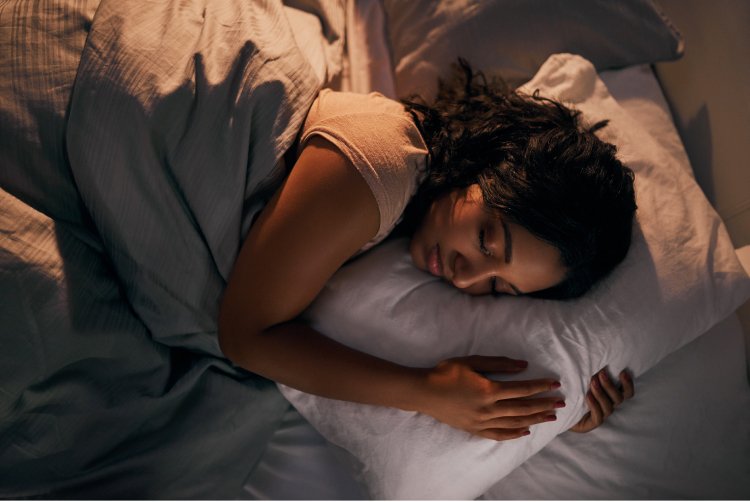8 best breathing exercises for sleep
Sleep better with mindful breathing exercises including 4-7-8 breathing, diaphragmatic breathing, alternate nostril breathing and other techniques.
Tossing, turning, staring at the clock... we've all spent restless nights longing for sleep to take hold. It's a familiar struggle that can leave you feeling drained and unproductive the next day. When insomnia hits, quieting your racing mind and relaxing your body can feel impossible.
Fortunately, it turns out that certain breathing techniques are scientifically proven to activate your relaxation response, dramatically reducing stress, and helping you fall asleep. Even a few minutes of mindful breathing or other breathing techniques has the potential to stop sleepless nights in their tracks.
How do breathing exercises help you sleep?
Slow, controlled breathing engages your parasympathetic nervous system, encouraging your body to move out of stress mode, and decreasing your heart rate and blood pressure. This can help you get sleepy.
Focusing intently on your breath keeps you anchored in the present moment. This helps to block out anxious thoughts about the future or regrets from the past that keep you mentally wired when you’re trying to settle in for the night.
Certain breathing techniques calm the body and mind. The more oxygen you’re getting, the less tension you feel. Extending your exhales will actually activate your relaxation response by stimulating the vagus nerve and reducing cortisol and adrenaline levels.
Incorporate breathing exercises into your bedtime routine
Incorporating breathing exercises into your bedtime routine can be a game-changer for your sleep quality. It's not just about the practices themselves but also about creating an atmosphere of relaxation and tranquility that signals to your body and mind that it's time to wind down.
Set the stage: Make your sleep environment as comfortable and soothing as possible. This could mean dimming the lights, turning off electronic devices, cooling down the temperature, or lighting a calming scented candle. The goal is to create a space that feels peaceful and inviting.
Establish a routine: Try to perform your breathing exercises at the same time each night. This consistency can help signal to your body that it's time to start winding down for sleep. And make breathing exercises the very last thing you do before getting into your comfy sleep position.
Choose your technique: Experiment with different breathing exercises to find the best one for you. You might find that certain techniques are more relaxing for you than others. Remember, there's no one-size-fits-all approach to relaxation and sleep.
Take your time: Don't rush through your breathing exercises. Take your time with each breath, focusing on the sensation of the air entering and leaving your body. This mindfulness can help to further promote relaxation and sleep readiness.
Use tools to help: Consider using tools like the Calm app to guide you through your breathing exercises. The app offers a range of resources, including guided breathing exercises to help you unwind for sleep.
8 breathing exercises to help you sleep
Improving sleep quality begins with the right techniques. We explore some of the best breathing exercises to help guide you towards a peaceful night's rest.
1. 4-7-8 breathing
The 4-7-8 breathing technique, also known as "relaxing breath," uses a long, controlled exhale to activate your parasympathetic nervous system, signal your brain to relax, decrease heart rate/blood pressure, and increase sleep-promoting melatonin.
Try it out:
Inahle for 4 seconds
Hold the breath in for a count of 7 seconds
Exhale long and slow for 8 seconds
Repeat
💙 You can pair this breathing technique with one of your favorite sleep-promoting sounds like this Alpine Meadow soundscape.
2. Diaphragmatic breathing
Diaphragmatic breathing can help you reduce stress in the body and mind, which can in turn, help you fall asleep.
Try it out:
Lie on your back and place one hand on your chest, the other on your belly
Inhale slowly and deeply into your abdomen, feeling your lower hand rise as your diaphragm fully expands
Exhale and feel your diaphragm lower
Keep your chest still. Repeat for 2-5 minutes
💙 Try this technique while listening to soothing Green Noise to help you nod off even faster.
3. Alternate nostril breathing
Alternate nostril breathing is a yogic breathing technique that involves alternately breathing in through one nostril and out through the other.
Try it out:
Gently close off one nostril with your thumb or index finger
Inhale smoothly through the open nostril
Switch sides to exhale through the other nostril
Inhale again on that side and continue alternating
💙 This helps balance your breathing and can be paired beautifully with soothing sounds like Theta Waves with Rain.
4. Progressive muscle relaxation (with breathing)
To try out this technique, you want to systematically tense each muscle group (feet, calves, thighs, etc) for 5 seconds, then completely relax for 30 seconds. As you do this, notice the sensations of tension melting away. Continue through your whole body.
While this isn’t a breathing technique in and of itself, you can encourage greater relaxation by including mindful breathwork.
Try it out:
Inhale before you tense your muscles
Hold the breath as you tense
Exhale fully as you relax the muscles
💙 Try progressive muscle relaxation with this guided Soften Into Sleep session.
5. Mindful breathing
Mindful breathing is about focusing on the breath and paying attention to each inhale and exhale. This simple act of mindfulness can help to quiet the mind and promote relaxation.
Try it out:
Find a comfortable position, either sitting or lying down
Close your eyes and take a deep breath in through your nose, filling your lungs with air
Exhale slowly through your mouth, releasing the breath in a controlled manner
Continue this pattern, focusing your attention on the sensation of the breath entering and leaving your body
If your mind starts to wander, gently bring your focus back to your breath
💙 Need some guidance? Try Breathing Room with Professor Megan Reitz.
6. Counting breaths
Counting the breaths helps to keep your mind focused, which can redirect your thoughts away from any worries or anxieties that are keeping you from sleeping.
Try it out:
As you inhale and exhale deeply into your belly, count each complete breath cycle from 1 to 5, then start back at 1 again
Visualize each number and subvocalize it as you complete each breath. This keeps you anchored in the present
💙 You can kick this practice into high gear by listening to curated music while you breathe. Try Ocean Lullaby by Harlan Silverman.
7. Bhramari pranayama breathing (humming bee breath)
Bhramari Pranayama, or "bee breath," is a yogic breathing technique that involves making a humming sound while exhaling. Visualize tension leaving your body through the vibration. This technique can help to calm the mind and reduce stress and anxiety.
8. Kumbhaka (4-4-8 rhythmic breath counting)
Kumbhaka is a rhythmic breathing practice that helps gently concentrate attention and still the mind. This can be very helpful when you’re trying to sleep. The practice involves pausing at specific points as you breathe and keeping the rhythm going so that it eventually lulls you to sleep.
Try it out:
Inhale for a count of 4
Hold the breath at the top of each inhale for a count of 4
Release the breath slowly for a count of 8 and repeat
💙 Join Tamara Levitt for a guided sleep rhythm with this Kumbhaka practice. Simply select your tempo and drift off to dreamland.
The more regularly you practice these breathing exercises, the more effective they will be. It might take some time before mindful breathing becomes instinctive, but be patient with yourself.
Remember, the goal of breathing exercises isn’t just to help you fall asleep but also to improve the quality of your sleep. By incorporating these exercises into your bedtime routine, you're taking a proactive step towards better sleep and, by extension, better overall health.
Common mistakes to avoid when practicing breathing exercises
While breathing exercises are generally simple and straightforward, a few common mistakes can hinder their effectiveness. Here's what to watch out for:
Rushing through the exercise
Breathing exercises are meant to be done slowly and mindfully. Rushing through the steps can counteract the relaxation benefits. Take your time with each breath, focusing on the sensation of the air entering and leaving your body.
Forcing the breath
The goal of these exercises is to promote relaxation, not force your body into a specific breathing pattern. If a technique feels uncomfortable, modifying it or trying a different one is okay.
Being inconsistent
Like any other form of exercise, consistency is key when it comes to breathing exercises. Try incorporating them into your daily routine rather than doing them sporadically.
Expecting immediate results
While you might feel more relaxed after a single breathing exercise, the most significant benefits come with regular practice. Don't get discouraged if you don't see immediate improvements in your sleep.
Ignoring your body's signals
If a particular breathing exercise makes you feel dizzy or lightheaded, it's a sign that you should stop and try a different technique. Always listen to your body's signals and adjust your practice accordingly.
Breathe yourself to sleep with Calm
Still struggling to unwind and let go of stress despite trying these techniques? Let Calm's meditation resources give you an extra sleepy boost:
Wind down with sleep meditations like Deep Sleep Relax with Tamara Levitt, which relax you from head to toe.
Get immersed in serene Sleep Stories like Crossing Ireland by Train with Cillian Murphy to distract racing thoughts.
Follow along with mindful breathing exercises like Breathe into Relaxation with Jay Shetty.
Release stored tension with some mindful movement like Evening Stretch.
With Calm's expansive sleep toolkit, you'll find the perfect mix of resources to help you destress and ease into dreamland with your new breathing skills.
Other questions about breathing exercises for sleep, answered
Q: How does the 4-7-8 breathing trick work?
The 4-7-8 breathing trick works by helping to slow down your breathing, which can have a calming effect on the mind and body. By focusing on your breath and following the specific pattern of inhaling for 4 seconds, holding for 7 seconds, and exhaling for 8 seconds, you can help to reduce anxiety and prepare your body for sleep.
Q: Can breathing exercises really help you fall asleep?
Yes, studies confirm practicing slow, deep breathing before bed initiates your relaxation response so you fall asleep faster. It also improves sleep quality by synchronizing your heart rate variability for restful sleep stages.
Q: What is 5-2-7 breathing?
The 5-2-7 breathing exercise involves inhaling for 5 counts, holding your breath for 2 counts, and exhaling for 7 counts. Like 4-7-8 breathing, the extended exhale promotes relaxation.
Calm your mind. Change your life.
Mental health is hard. Getting support doesn't have to be. The Calm app puts the tools to feel better in your back pocket, with personalized content to manage stress and anxiety, get better sleep, and feel more present in your life.












